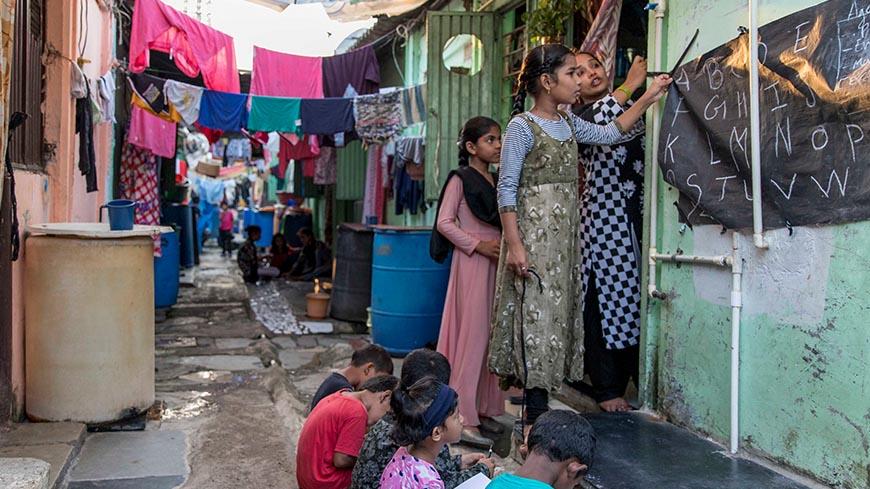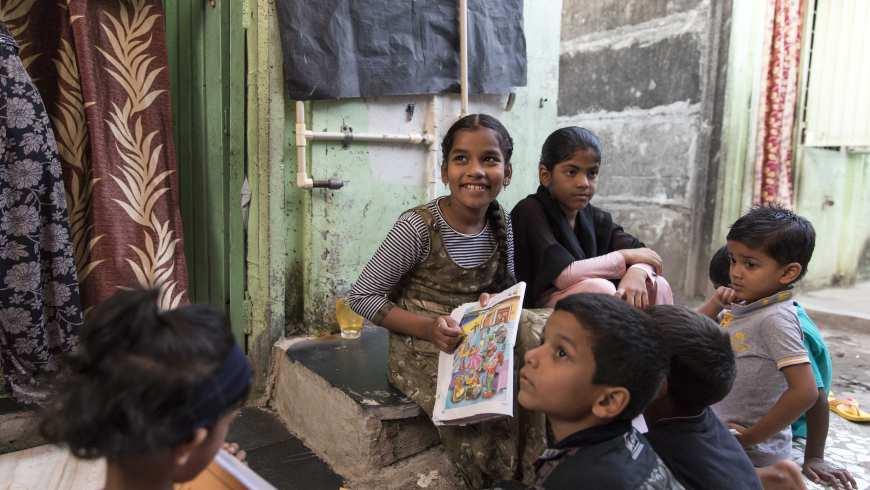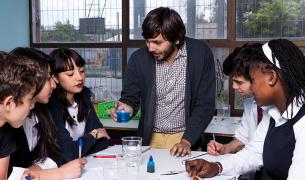Spreading a Love of Learning: A Fifth Grade Student Sparks Change in Her Community

Saliha had spent the entire weekend preparing for an hour-long learning session for kids in her community. A fifth grader, Saliha believed in the transformative power of education, and was determined for her pupils, a group of kindergarten kids and first graders, to be interested in and excited about learning.
They had been waiting patiently with notebooks and pencils in hand while Saliha wrote out the alphabet on an improvised blackboard. When she turned around with poise and self-assurance signalling that she was ready for class to begin, her students were rapt with attention.
In the alleys and open spaces of Sion TT, a low-income community in central Mumbai, other kids were playing marbles, snakes and ladders, and hide and seek—a normal Sunday evening scene. But outside Saliha’s home, in her makeshift classroom set up under an old election campaign poster used as a shamiana (canopy), a handful of children had chosen to skip the regular evening pastimes. With a little prodding from their parents, but mostly from their own volition, they decided instead to attend a learning session led by Saliha, an 11-year-old girl. Something remarkable was underway.
Saliha’s learning journey could not look more different from those of the children she is now teaching. Each of her pupils attends a low-cost private school, the likes of which have now proliferated across Indian cities. These schools have low tuition, which families scrape together from their modest monthly earnings in hopes of better infrastructure, resources, and learning outcomes than their local public schools provide. For many of the gritty individuals who invest a significant chunk of their income into their children’s education, however, these hopes are far from fulfilled. “The tuition fees are increasing but the amount of learning is decreasing,” remarked a parent of one of Saliha’s young students.
Four years ago, Saliha was placed in a second grade Teach For India classroom in Worli, an affluent area of Mumbai dotted with a number of low-income communities. That classroom happened to be the one that I and my colleague Juhi, both Teach For India Fellows, were leading that year. When Juhi and I begun our journey as passionate and idealistic first year teachers who had lofty visions for our 45 students, not one of them knew all of the letters of the alphabet or how to say their name in English. We quickly focussed on building their academic foundations and creating a culture of interdependent learning. Juhi and I were fortunate to have Saliha as one of the students who was quick to teach her peers after mastering a concept herself.
Since then, Saliha has had Teach For India Fellows as teachers each year, like her current teacher Shivani, who have nurtured and supported her, and given her opportunities to explore her potential. Their influence is evident in Saliha’s teaching, from the norms that she’s set in place in her community classroom—“keep your things properly, hands and legs to yourself, collaboration means to help everyone”—to her teaching strategies. Saliha has clearly absorbed the values of her own learning environments and has deeply internalized the role that she can play for others by investing in them, and sparking their own interest in learning.

And in Saliha’s community classroom, the hunger to learn was palpable. After they had written the whole alphabet in neat handwriting, Saliha removed “test papers,” which she had drafted the previous night, from a professional looking handmade paper folder, and distributed these to her students. They buzzed with excitement at the prospect of applying the letter sounds they had just learned in a dictation test of simple, two letter words. As Saliha read them out—“It, on, am …”—her students quickly wrote the spellings and then looked up, eagerly anticipating the next word.
In Saliha's and her students’ community, investment in education encompasses the primary hope that parents hold for a better future for their kids. Working as taxi drivers, caregivers, or factory workers, most parents earn a combined monthly income of around $300, just enough to support their families. They also grapple with a host of challenges from violence to sanitation.
Just outside Saliha’s home—a 10x10 room under a corrugated steel roof—her community classroom was an unlikely oasis of learning in the middle of difficult circumstances. As she made her way through the lesson, Saliha battled with a host of disruptions—water gushing through exposed drainage pipes, neighbours walking by carrying piles of clothes and buckets of water, and televisions blaring out of almost every home in the vicinity—but she and her students remained focussed and persistent.
Saliha recently shared something profound with Shivani: “When we teach other kids, it makes us value our own education and the motivation to learn better.” As a teacher, I often felt bogged down by the inequity, wondering about the reality of the classroom one wall away. The realization that a fifth grader who I once taught has now recognized that same inequity and acted on it by creating opportunities for other kids, sharing her gifts and love for learning, deeply moves me. Across Teach For India, we’re seeing students, like Saliha, emerge as role models in their communities, dedicated and invested in spreading an excellent education to other children.
Saliha’s mother is an incredibly supportive presence not only in her life but also in Saliha’s learning center. Over the course of the evening, she tied and re-tied the piece of plastic serving as a blackboard, individually checked in with each child about whether they had brought their homework, and tried to minimize distractions. As the lesson wound up, I asked Saliha’s mother about her daughter’s journey. “Bhaiya (brother),” she said, “I am thrilled because my daughter is getting ahead, working hard, and now helping others.”
While Saliha spent an hour teaching the basics of literacy and phonics, her mother distilled the most powerful lesson that Saliha had shared: the power of education is that it not only gives one a chance to improve one’s own life but to contribute to a better world, too.
The Kids Education Revolution (KER) brings students and teachers together to collectively reimagine education. Follow Kids Education Revolution, Teach For India, and Teach For All on social media for updates from the KER National Summit in Mumbai, February 9-10!



